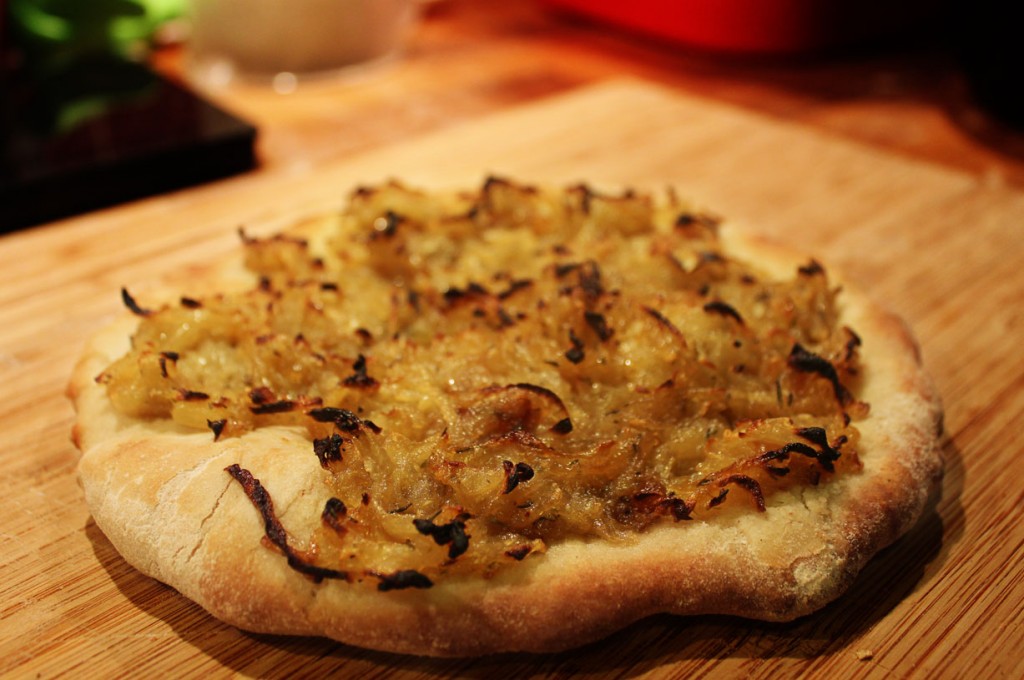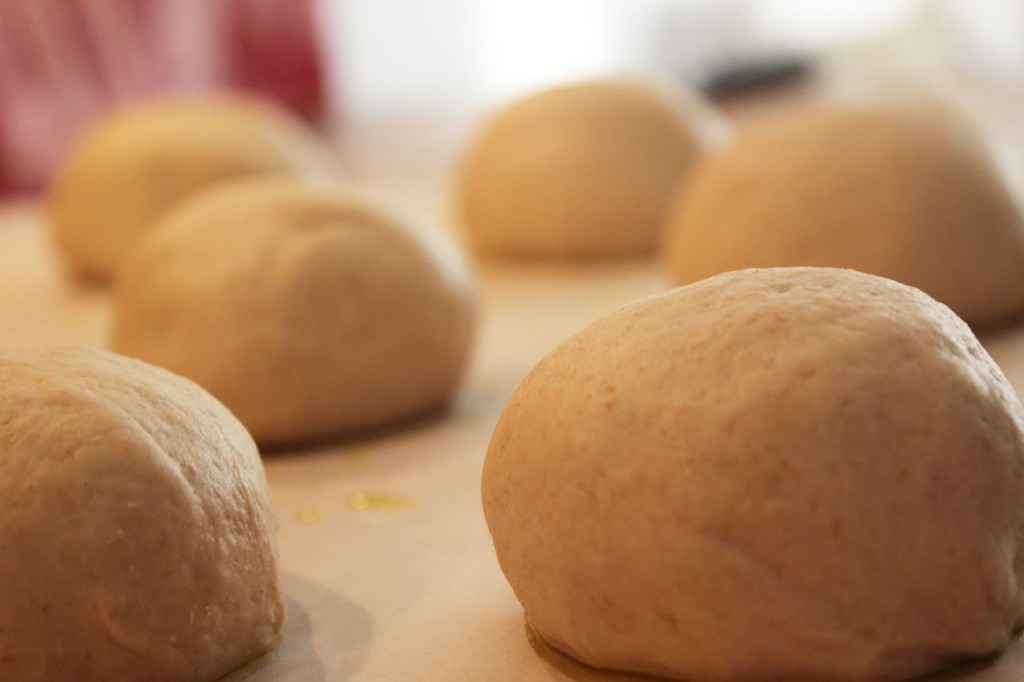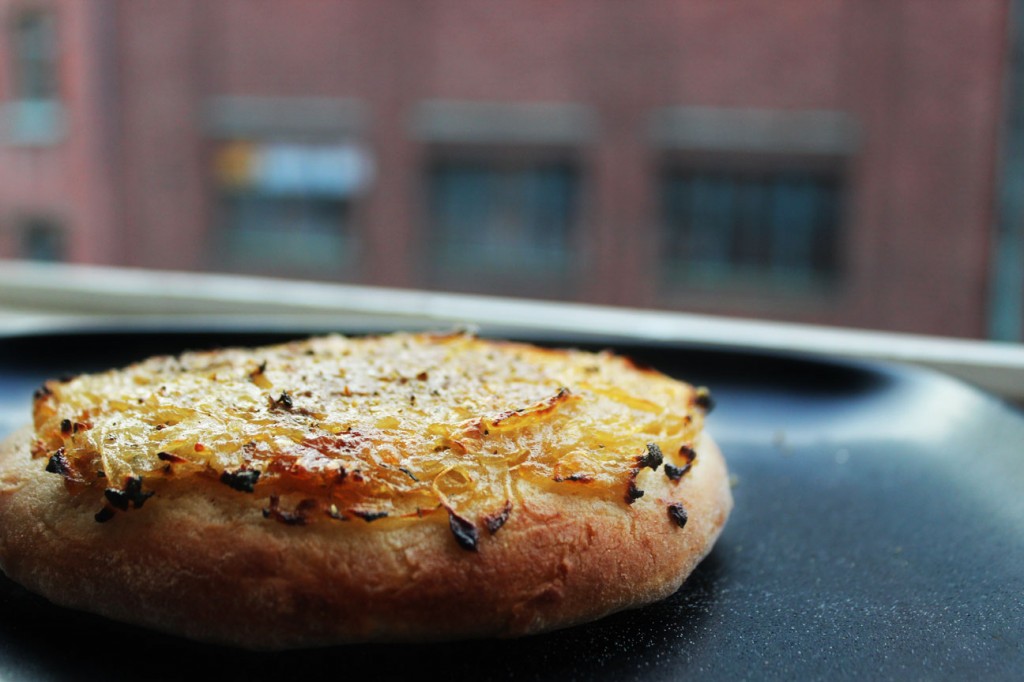The delicious French pissaladière

Pissaladière, or pissaladiera in Nissart (the dialect from Nice, in the South East of France) is a variation of the pizza that doesn’t include tomatoes. Or the Italian pizza is a variation of the French pissaladière, depends on what you think came first. The traditional recipe is simply a thick bread base, we’re talking the thick Chicago style crust in a pan, topped with a bed of caramelized onions. Although pizza dough and onions are sufficient for it to taste amazingly good, the real pissaladière needs pissalat. What is pissalat, you ask? Pissalat is the French name for a kind of paste made from salted sardines and salted anchovies. In fact, the pissalat gave its name to the pissaladière, since in Nissart peis salat simply means salted fish. Nowadays, the pissalat is often replaced with anchovy fillets. There are also variations, where small black olives from Nice are added, so called caillettes.
An italian recipe (from Liguria) exists, that is a mix between pizza and pissaladière, called piscialandrea. It contains tomatoes, unsalted anchovy fillets, black olives and garlic. Now, enough with the ethymologic courses. Let’s start with the food making!
This dough recipe can be used for any kind of pizza. It’s a wonderful dough, full of flavor, and an excellent crunchiness and chewiness, all at the same time. You choose how thick you want it, and what you want to top it with, but the classic pissaladière does have a thick crust. It yields about 8 small pissaladières, or four large ones.
Day 1 you’ll need
- 120 g of flour (the “tipo 00” equivalent)
- 70 g of cold water (100 grams per dl if you prefer volume, I just happen to weight stuff)
- 1/2 tsp of malt syrup
- 4 g of bread yeast (the dried kind)
Day 1 you’ll do this
- Mix flour, syrup, and water. In a large bowl. In case you wonder, the malt syrup is not only to quickly feed the yeast, it’s also there to give the pizza dough a rich flavor and scent. It has almost a sourdough tone. The reason I’m not using sourdough, is because I actually prefer the texture of a yeast based pizza dough. One can of course mix sourdough and yeast, but let’s save that one for another recipe.
- Run it in a kneading machine for 4 minutes (unless you have strong hands, in which case it will probably take you closer to 10 minutes).
- Leave the dough to rest for 15 minutes, or even longer than that. The osmosis (you know, the effect that makes water “climp” up flours and trees) will make sure the water spreads throughout the dough. It should be quite dry, tacky and elastic, if it’s not, let it rest for another another 5-15 minutes.
- Now add the dry yeast, and mix for another 4 minutes.
- The pre-dough is ready, and is now to rest in the refrigerator for 48 hours. The yeast fungus will multiply like crazy, and the lump will have a distinct and wonderfully yeasty smell to it, and that flavor is what we’ll be using for our main dough in two days from now.
Day 2 (well, actually 3) you’ll need
- 350g of flour (the “tipo 00” equivalent)
- 200g of cold water
- 5 g of bread yeast (dry)
- 1 tsp malt syrup
- 1 tsp of salt
- 400 grams of canned tomato (I prefer the canned pulp, that’s what I’m using)
- 2 tbsp of anchovy paste
- 2 tbsp of olive oil
- 1 star anis
- 2 tsp of thyme
- 10 onions if you’re turning all the dough into pissaladières. I like making a couple of pizzas and some of these, I like variation.
Day 2 you’ll do this
- Start with slicing the onions very thinly. Use your mandolin if you have one. Heat up some oil in a large pan, and slowly let the onions caramelize together with the star anis and the thyme (it enhances the onion flavors), and some salt (but very little, the anchovy we’ll be adding later is already salty). This process of slowly cooked onion, will take up to two hours, so start with this before moving on to the rest.
- Mix flour, syrup, and water in a large bowl, just like day 1 but with other quantities.
- Run it in a kneading machine for 4 minutes (unless you have strong hands, in which case it will probably take you closer to 10 minutes).
- Leave the dough to rest for 15 minutes, or even longer than that. The osmosis (you know, the effect that makes flours and trees “suck up” water) will make sure the water spreads throughout the dough. It should be quite dry, tacky and elastic, if it’s not, let it rest for another another 5-15 minutes.
- Now add the dry yeast, the salt, and the lump of dough from the day before yesterday. Mix it all for another 4 minutes.
- The wonderful pizza dough is ready. Make around 8 balls, and set aside to let them double in size.
- By now, both the dough balls have doubled in size, and the onion is all brown and soft. It’s time to make the beauties.
- Mix oil and fish paste.
- Flatten the bread, but not too thinly. A pissaladière should be quite thick, almost like a freshly baked bread with toppings. Add the caramelized onions, and a dash or two of the fish and oil mix.
- Heat the oven to 250 degrees celsius, and bake your delicious French pissaladière.
- Done!



